Shortcrust Pastry for sweet and tender tart and pie crusts that bake up reliably perfect every time.
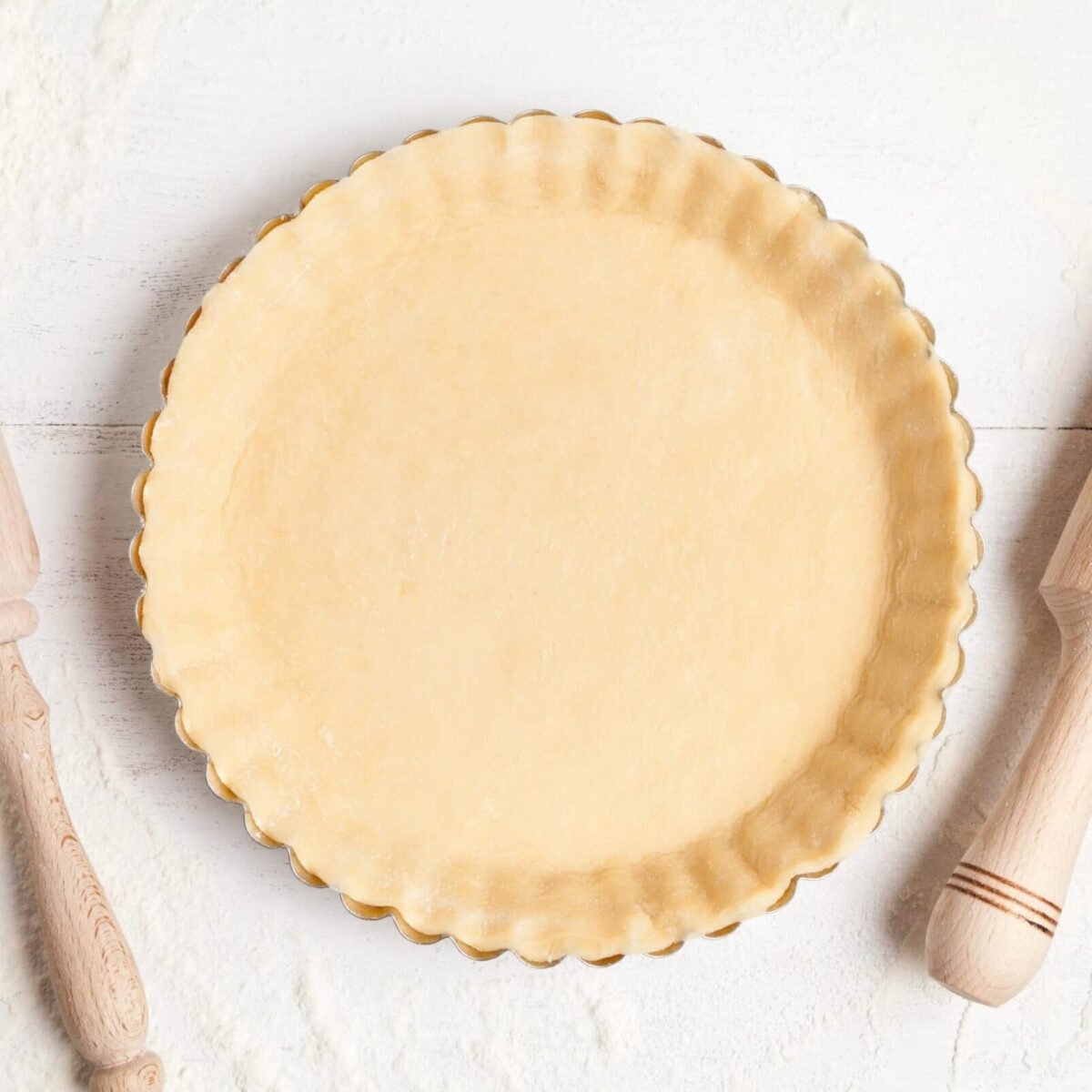
I used to struggle with tart and pie crusts that either shrank in the oven or cracked when rolled out. After experimenting extensively with my flaky pie crust recipe, I mastered the science behind perfect pastry.
I've now applied everything I learned to this shortcrust pastry recipe, so you can make flawless sweet tart crusts every time. In this post, I'll walk you through every step of making your own shortcrust pastry - from making the dough to rolling it out, lining your pie dish, and blind baking it to golden perfection.
Jump to:
Why You'll Love This Easy Shortcrust Pastry Recipe
- Foolproof recipe full of tips, suggestions, and step-by-step visual cues.
- The most buttery, tender pastry crust that's perfect for sweet and savory dishes.
- Freezable shortcrust pastry you can make ahead of entertaining.
What Is Shortcrust Pastry?
Shortcrust pastry is a type of pastry used to make crusts for tarts, pies, and quiches. Its texture is finer and more crumbly than that of a flaky pie crust, which makes it ideal for delicate desserts. It's made by cutting cold butter into flour, which "shortens" the gluten strands to give a fine, crumbly texture. In baking, 'short' means crumbly - just like in shortbread!
There are three main types of shortcrust pastry:
Pâte Sucrée - That's this recipe - a classic sweet shortcrust pastry that is perfect for sweet desserts like Bakewell Tarts or fruit tarts.
Pâte Brisée - A savory pastry dough with less or no sugar, commonly used for quiche and savory pies.
Pâte Sablée - A softer, more sandy sweet pastry than pâte sucrée, with a higher butter and sugar content. This gives it a rich flavor but makes it harder to work with - it often needs to be pressed into the tart pan rather than rolled out.
Ingredients for Shortcrust Pastry
This pastry uses very few ingredients, but there are lots of important things to note to make the shortcrust pastry just right. These are the same simple ingredients as a basic pie dough, but the ingredient amounts and the process are different.
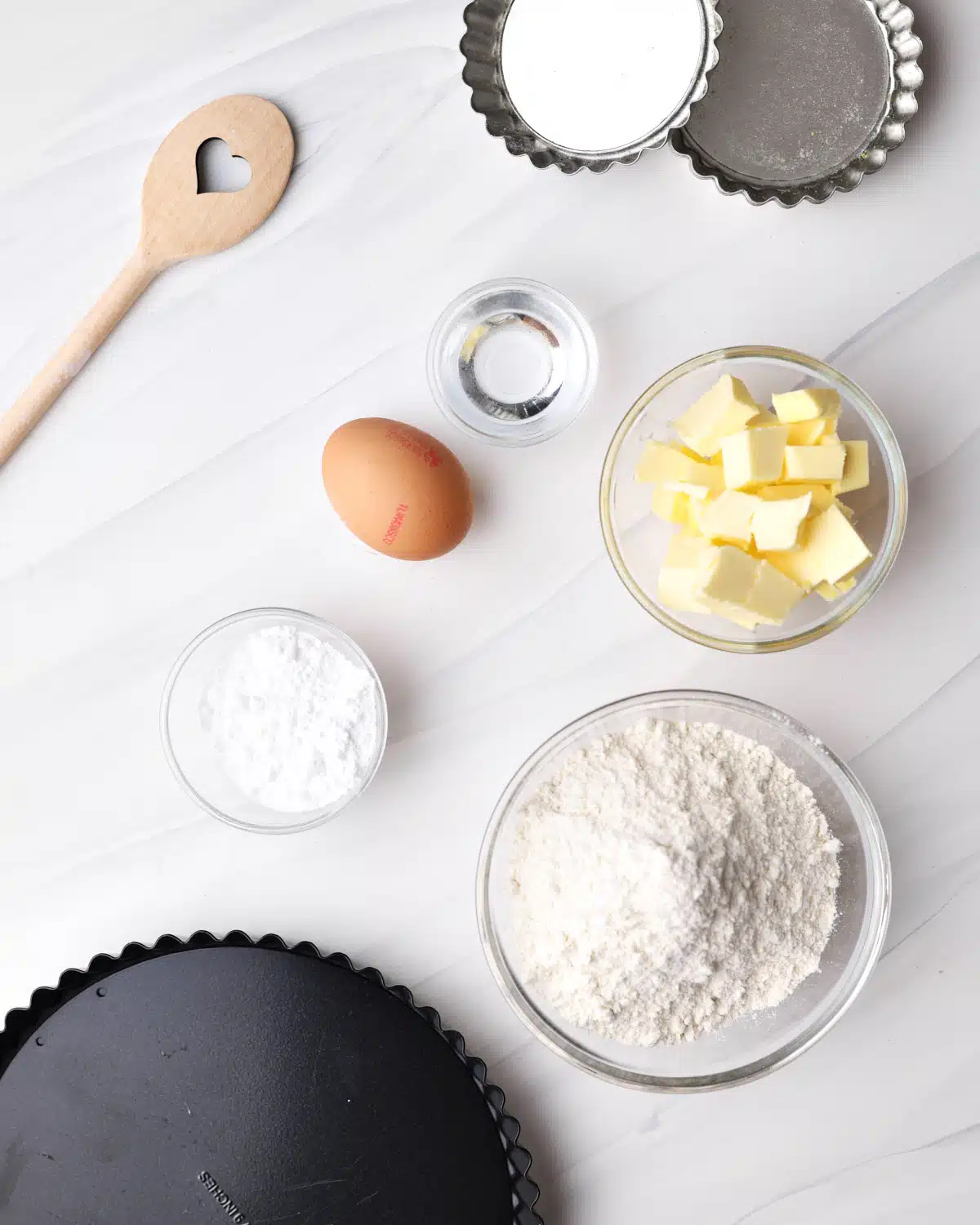
- Flour - All-purpose flour (plain flour) gives the pastry just enough structure to hold its shape well, whilst keeping the dough tender and crumbly.
- Butter - Use unsalted butter, preferably high-quality. European butter has a higher fat content that gives the pastry a richer flavor and melt-in-the-mouth texture. It is essential that your butter stays as cold as possible. Cut the butter into small cubes before beginning.
- Powdered Sugar - This is a sweet pastry, so a little sugar is essential! Powdered sugar (icing sugar) is ideal for shortcrust pastry dough because it dissolves so easily, creating a delicate texture and smooth consistency. If you're making a savory shortcrust pastry, just use 1 tablespoon of sugar instead.
- Egg - We'll just need 1 egg yolk for this recipe to help the mixture stick together. Use large, free-range eggs where possible.
- Water - It's essential that the water is ice cold to prevent the butter from melting too soon. The water will help to bring the dough together and hydrate the flour, creating a nice, firm structure.
See the recipe card for quantities and the full recipe.
Recommended Equipment
- Food Processor
- Tart Pan or Pie Dish
- Pastry Brush
- Pie Weights (if blind baking)
How To Make Homemade Shortcrust Pastry
This is a very easy recipe, but pay attention to the small details to make sure you get the best results every time.
Before you start, make sure your butter and water are nice and cold - it's a step you can't afford to miss!
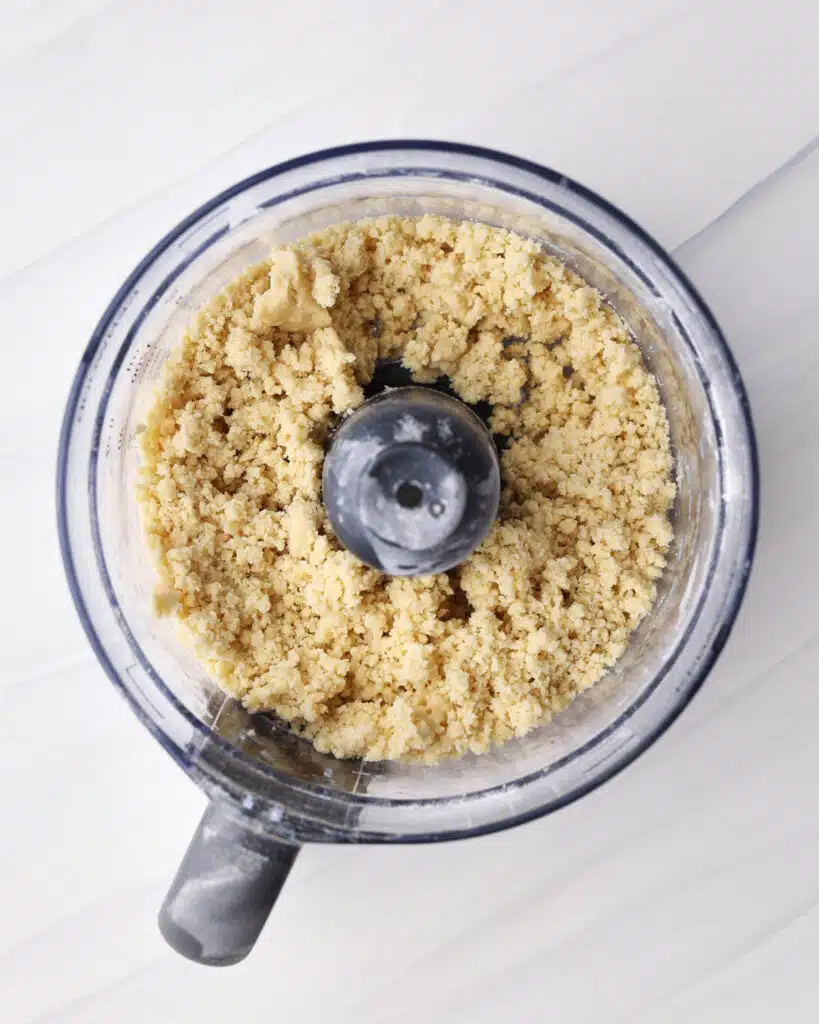
Dry Ingredients and Butter
Place the dry ingredients (powdered sugar and flour) into a food processor along with the chopped chilled butter.
Pulse until the butter is in small pieces and it looks like a fine breadcrumb-like texture.
This can be done by hand or with a pastry cutter, but the food processor helps to keep the butter cold.
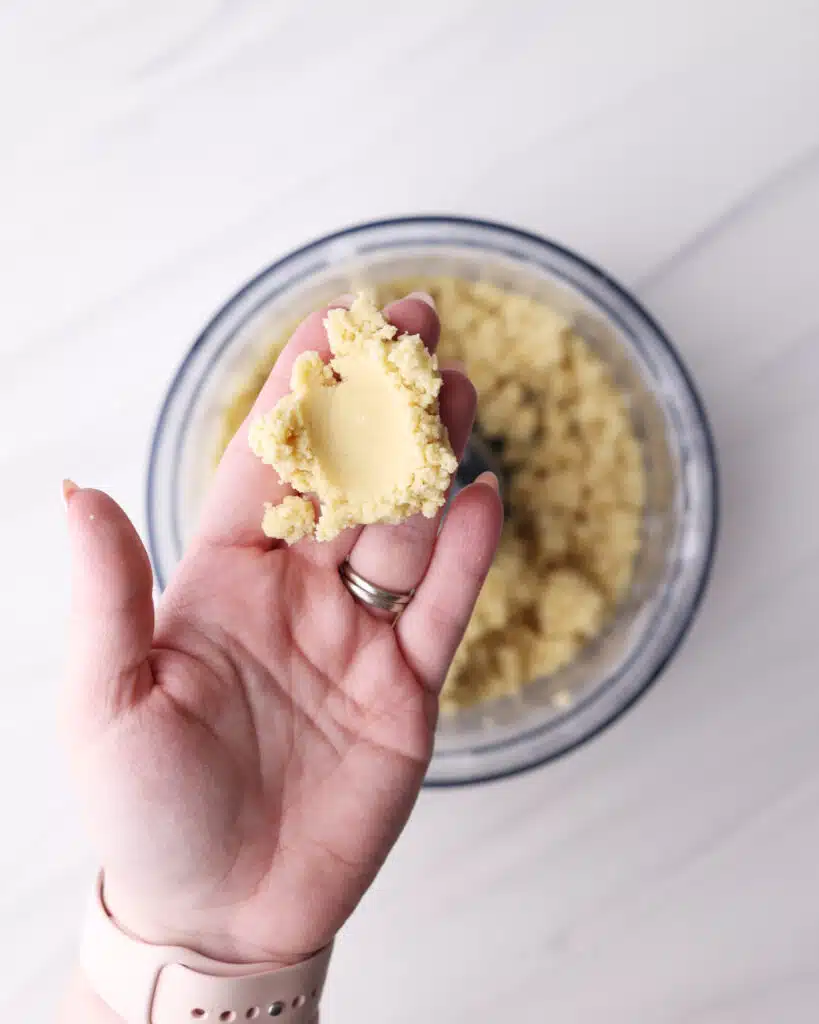
Wet Ingredients
Add the egg yolk and 1-2 tablespoons of ice-cold water into the processor, and pulse.
Keep adding water, one tablespoon at a time, until the mixture is hydrated enough that you can squeeze it together with your fingers and it holds its shape.
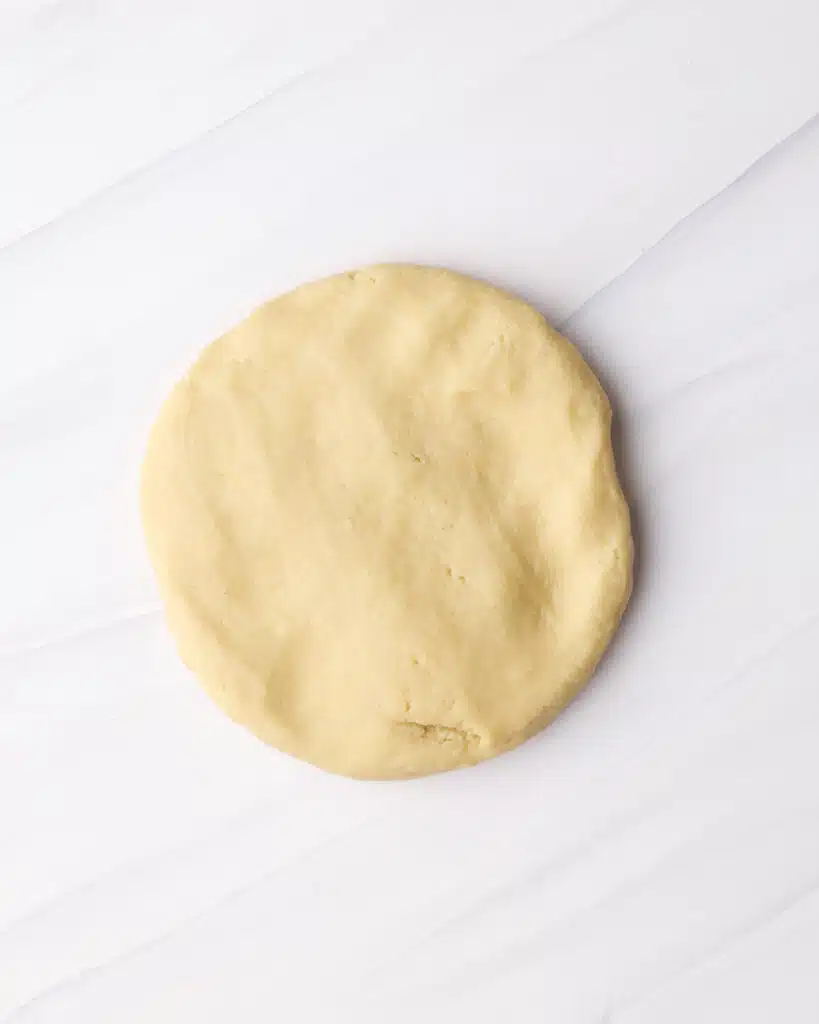
Knead and Chill
Tip the mixture out onto a clean work surface, and knead it together gently with your hands. Do this just until it becomes a smooth dough, being careful not to overwork the dough.
Once the ball of dough is formed, flatten it into a disk shape and wrap up in plastic wrap. Refrigerate for 1 hour.
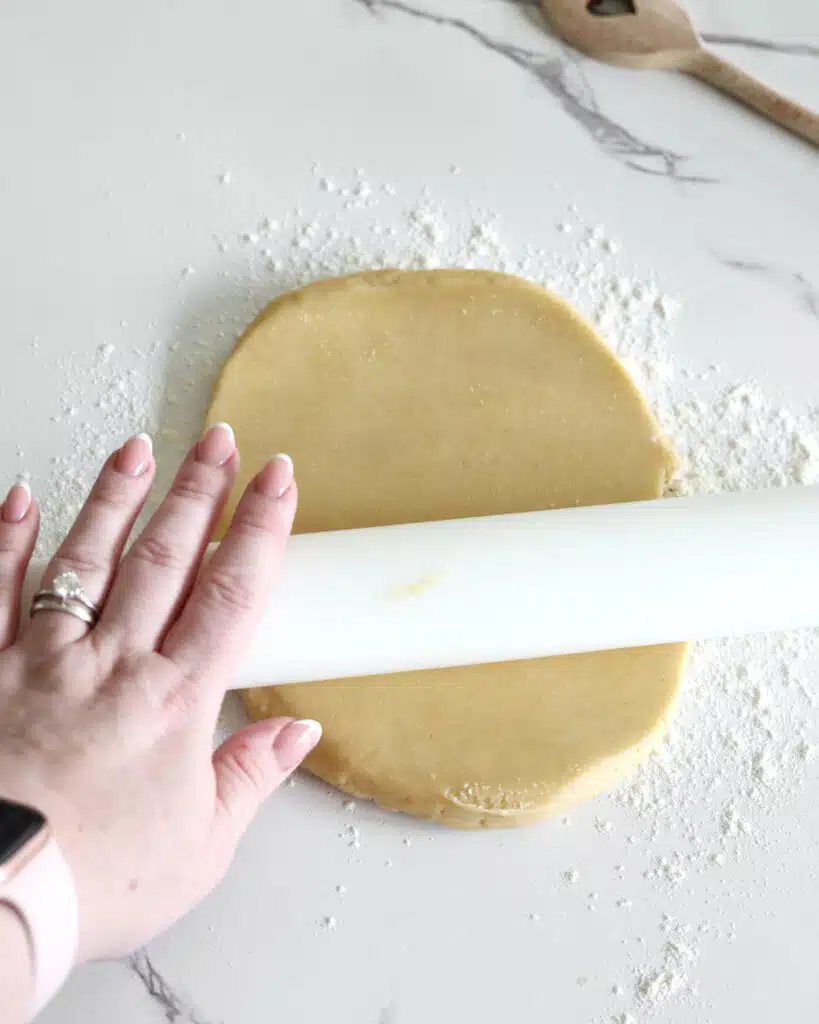
Roll the Dough
Take the shortcrust dough out of the fridge and let it sit for a few minutes to warm up a little bit. Then, place the chilled dough on a lightly floured surface and roll it out with a floured rolling pin to about ⅛ inch (3mm) thick.
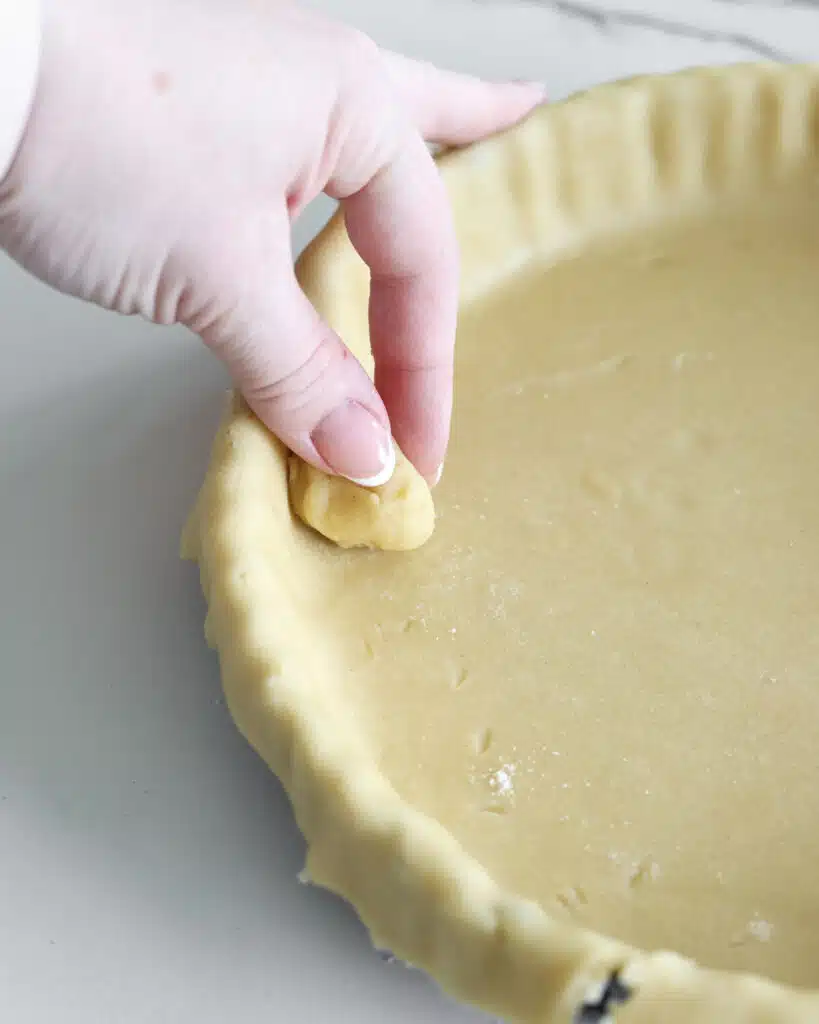
Line the Pan
Lift the rolled dough into an ungreased tart pan or pie dish, and gently push the pastry down into all the edges and crevices.
Trim away any excess pastry that hangs over the sides of the tart tin, and chill for at least 30 minutes before baking.
How To Blind Bake Pie Crust
If your recipe calls for a pre-baked or par-baked crust, you will need to blind bake the pastry. It's called 'blind baking' because we can't see how it bakes as it's under pie weights. The pie weights stop the pastry from bubbling up or shrinking down the sides of the tart pan.
If your recipe calls for unbaked crust, just proceed with the recipe instructions and bake the filling and crust according to those.
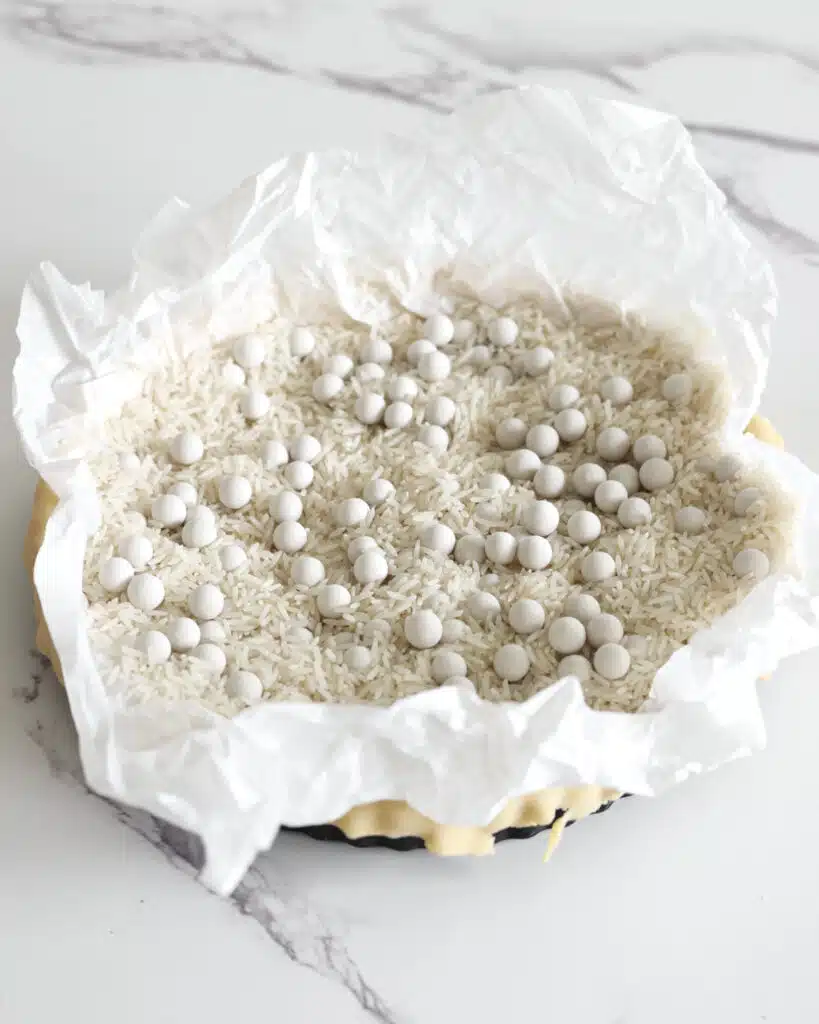
Pie Weights
Scrunch up some parchment paper, then unwrap it and lay it over the chilled pastry. Cover with pie weights (I like to use a combination of baking beans and rice). Make sure the weights go all the way up the sides of the crust.
Put the crust back in the fridge (or freezer) while you preheat the oven to 400°F / 200°C (180° fan-assisted).
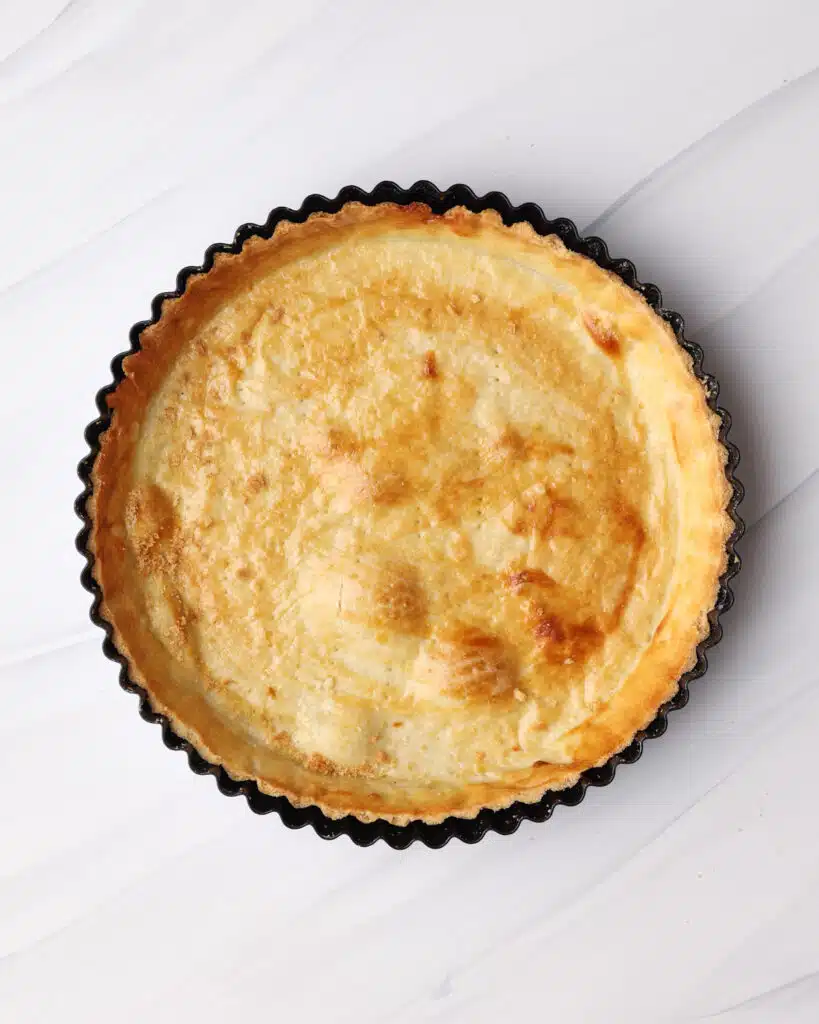
Bake
Blind bake for 15 minutes, then remove from the oven. Carefully lift the pie weights out using the parchment paper and set them aside.
If you are using a wet filling, it's best to add a thin, even layer of eggwash onto the tart case to help seal it. Skip this step if not needed.
Return it to the oven and bake for a further 10 minutes, or until the pastry crust turns a lovely golden brown color.
Shortcrust Pastry Tips
Making shortcrust pastry is really easy once you get all the techniques down, so be sure to take note of these tips if you want your pastry to be the best it can be!
Chill OUT - This goes for the ingredients, the dough, and you - your hands more specifically. It's super important to keep all the elements of shortcrust pastry nice and cold before baking, to ensure the cubes of butter don't melt too much and leak out of the shortcrust when baked. If this does happen, the pastry will most likely collapse on itself in the oven.
Gently does it - As shortcrust pastry is lovely and tender, we must be careful not to overwork it. Try to be as gentle as possible when kneading the dough, only doing so until it becomes a smooth dough and no more. The same goes for pushing it into the pan - avoid stretching it out to prevent it from tearing or shrinking whilst it bakes.
Just a little flour - It's easy to go a bit flour-crazy when we dust the work surface, in fear of the dough sticking too much. For this recipe, you need to use the flour sparingly, as too much will disrupt the texture of the pastry, making it quite dry and hard to work with.
Pretty pastry - In an ideal world, our pastry would be perfectly smooth with clean edges. This is difficult to achieve with shortcrust pastry having a mind of its own, but there are a few ways to help it look pretty flawless. If the pastry tears at all whilst you're lining the pan, simply wet your fingers a little and gently press the torn pastry back together. Additionally, pastry tends to shrink a bit whilst it bakes, so I always like to allow a little extra to hang over the tin when I trim it down.
How to Use Sweet Shortcrust Pastry
Shortcrust is one of the most versatile pastries and can be used as the base for so many different desserts, including homemade pie crust.
- Sweet Pies - If you're after a tender, melt-in-the-mouth pie crust, this is the recipe to choose! Use it as a base for sweet pies like Strawberry Pie, Custard Pie, Chocolate Mousse Pie, Banoffee Pie or Raspberry Meringue Pie - any pies that use flaky pie crust recipes can also use shortcrust pastry instead.
- Sweet Tarts - I love to use this type of pastry for my Bakewell Tart, but it also works great for miniature tarts as well. Separate it into mini tart tins for Strawberry Custard Tarts, chocolate ganache tarts, or lemon curd tartlets.
- Shortcrust Bars - Little bars are the perfect way to downsize your shortcrust pastry into mini desserts to enjoy on-the-go - you have to try them! Use this pastry as a sturdy yet tender base for lemon curd, caramel, chocolate, cheesecake, or fruit-flavored bars.
- Savoury Bakes - For a savory version of this shortcrust pastry, just leave out the sugar, or reduce it to just 1 tbsp. Use for a savoury tart or quiche crust.
Storage
Store your baked shortcrust pastry in an airtight container at room temperature if it's being used on the day.
You can make the pastry ahead of time and store it in the fridge for up to 2 days or in the freezer for 2 months. Let the frozen shortcrust pastry
Shortcrust Pastry FAQs
There are several things that contribute to shrinking pastry in tarts and pies. To avoid this, make sure you :
- Don't overwork the pastry dough
- Keep the shortcrust pastry cold throughout the whole process
- Don't stretch the dough or roll it out too thinly
- Thoroughly chill the crust once it's in the pan (at least 30 minutes)
- Use pie weights all the way up the sides to support the pastry
The egg (more specifically, the egg yolk) in shortcrust pastry is essential for creating a sturdy structure that will hold well when sliced, especially with wet or heavy fillings.
It is so important that shortcrust pastry and the chilled ingredients (butter, water), are kept nice and cold before baking. If not, the butter will start to melt too early and leak out of the crust whilst baking - causing the pastry to cave in on itself.
Shortcrust pastry usually needs around 2-4 tablespoons of ice-cold water. To test if enough water has been added, squeeze some dough in your fingers between each water addition. It will be ready when the mixture stays together when you press it down.
Shortcrust pastry and puff pastry are very different. Puff pastry has flattened layers of cold butter 'laminated' into it, which creates steam pockets as it bakes to make those signature flaky layers.
Shortcrust pastry on the other hand, has the butter cut through it more evenly for a more tender, homogenous texture
Some pie dough recipes will replace some or all of the butter with vegetable shortening. This can make it easier to work with, but personally, I will always prefer the flavor of an all-butter shortcrust pastry.
Tart and Pie Recipes
This sweet shortcrust pastry would work beautifully with any of these delicious tart and pie recipes:
Recipe
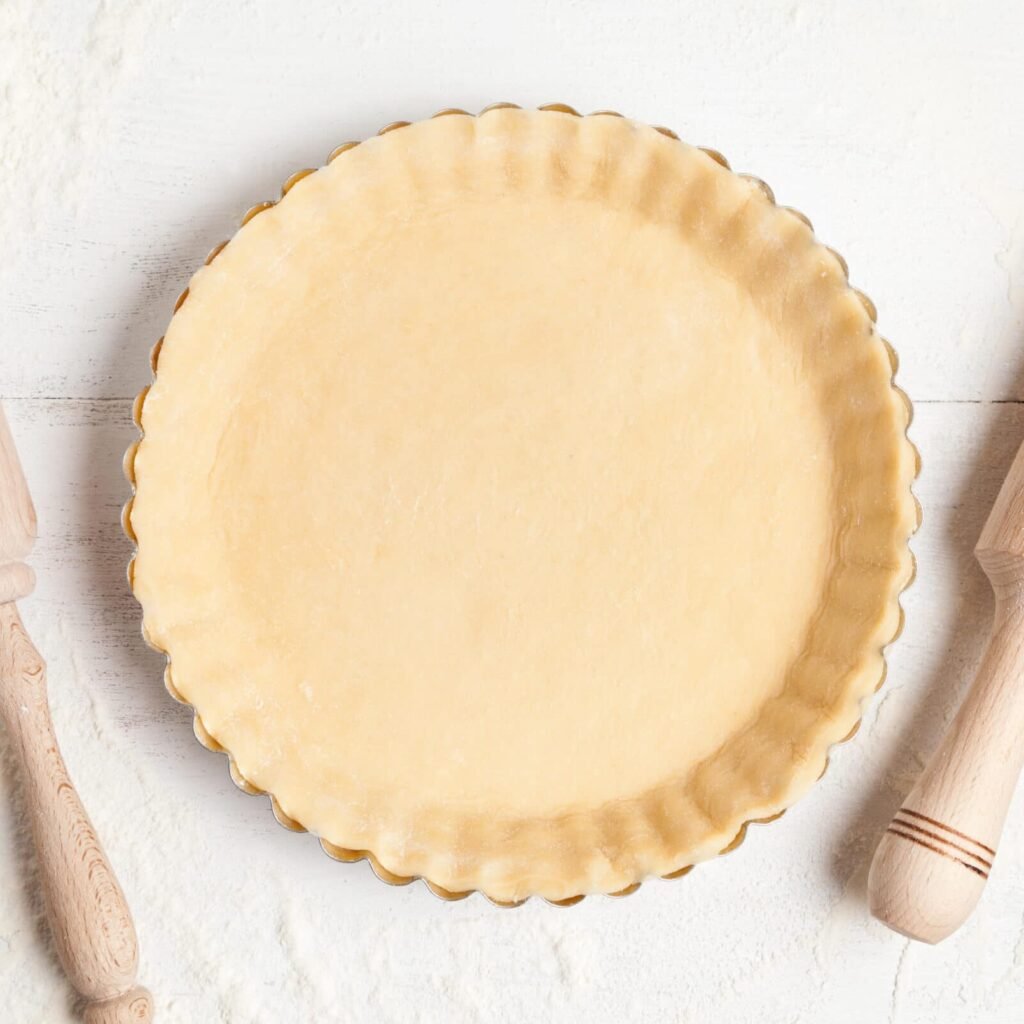
Shortcrust Pastry Recipe
Ingredients
- 1 ⅔ cup All-purpose Flour 200g
- 1 stick Unsalted Butter 113g (cold and cubed)
- ¼ cup Powdered Sugar 30g
- 1 Large Egg Yolk
- 2-4 tablespoon Water (cold)
Equipment
- Tart pan or pie dish
- Food Processor or pastry cutter
Instructions
- Add the flour and powdered sugar to a food processor and pulse to combine.1 ⅔ cup (200 g) All-purpose Flour, ¼ cup (30 g) Powdered Sugar
- Add the cold butter and pulse until the butter is in small pieces and the mixture looks like fine breadcrumbs.1 stick (113 g) Unsalted Butter
- Add the egg yolk and 1-2 tablespoons cold water and pulse again. Keep adding water, one tablespoon at a time, until the dough is hydrated enough that it comes together when you squeeze it between your fingers.1 Large (1) Egg Yolk, 2-4 tablespoon (2 tbsp) Water
- Tip the mixture out onto a work surface and use your hands to gently knead it together, just until it is a smooth dough - don't overwork the pastry.
- Flatten it into a disk, wrap in plastic wrap and refrigerate for 1 hour.
- Once you are ready to bake your pastry, take it out of the fridge and let it sit for a few minutes to warm up.
- Roll the pastry out on a lightly floured work surface until it is about ⅛ inch (3mm) thick. Lift into your tart case and push the pastry down into all the crevices. Trim the edges of the pastry.
- Return to the fridge for at least 30 minutes or until ready to bake.
- If your recipe requires you to par-bake or fully blind bake your pastry case, follow these steps. If your recipe requires an unbaked pastry case - proceed with he baking instructions of that recipe.
- Scrunch up some parchment paper, then unwrap it and lay it on top of the chilled pie crust. Fill with pie weights all the way up the sides of the crust to support it. Then return to the fridge or freezer while preheating the oven to 400°F / 200°C (180 fan-assisted).
- Bake for 15 minutes, then remove from the oven and carefully lift the pie weights out using the parchment paper.
- If you are using a wet filling, it's best to apply a thin layer of egg wash to help seal the pastry and stop it from getting soggy. You can skip this step if not needed.
- Return the uncovered pastry crust to the pan and bake for 10-15 minutes further until golden.

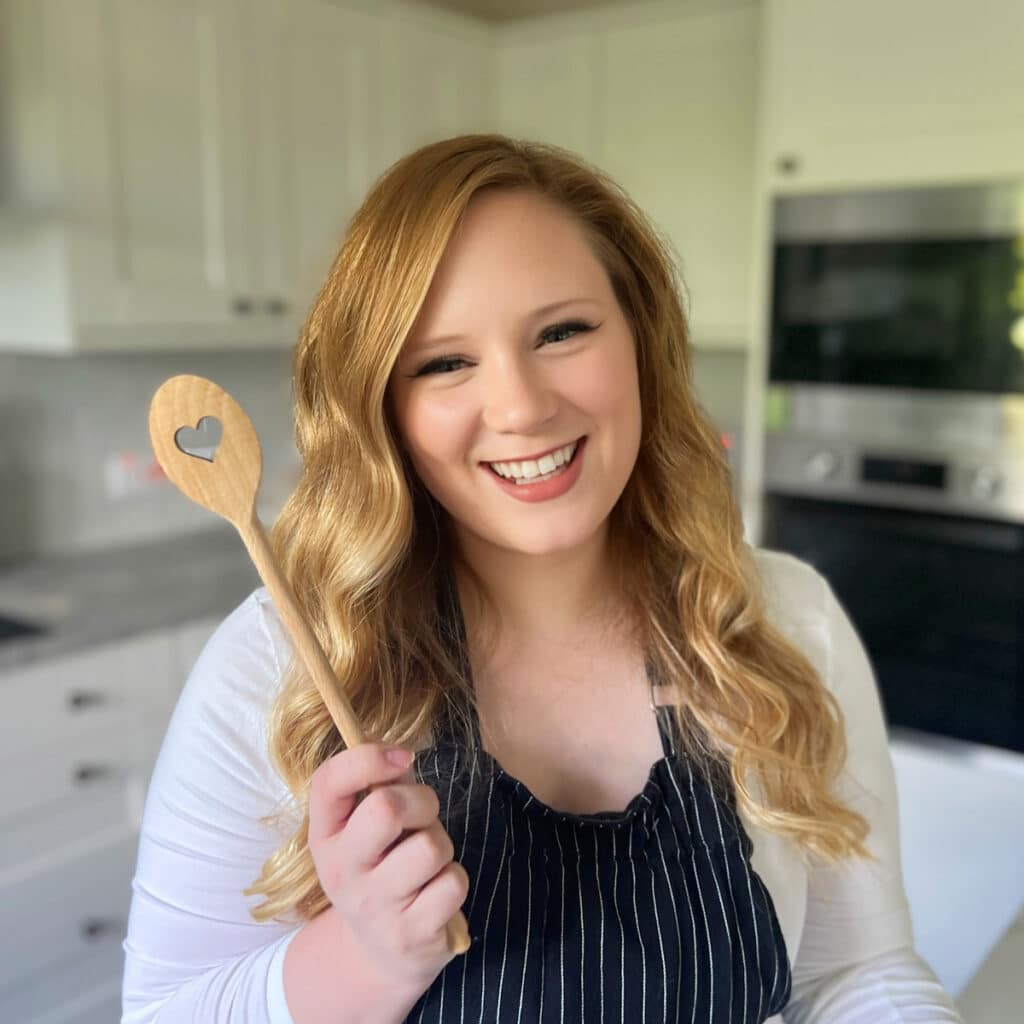
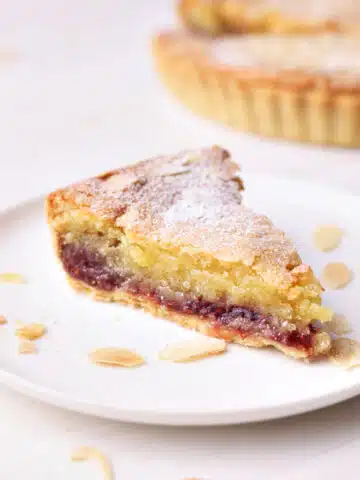
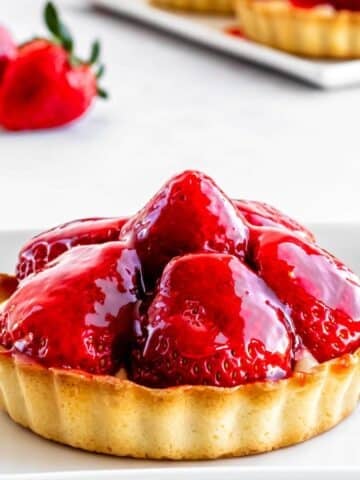
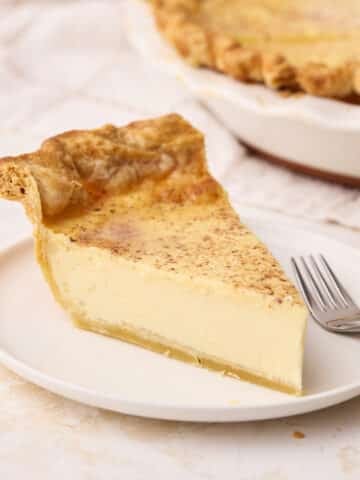
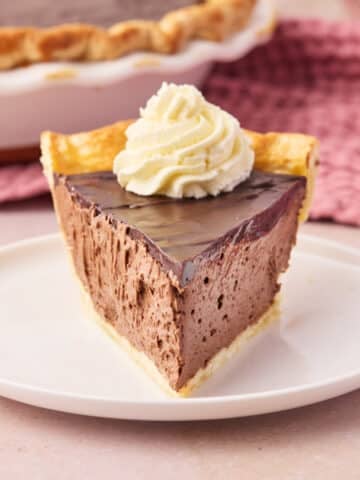
Hi, I'm Jules!
I'm a Scottish ex-bakery owner sharing my tried and true dessert recipes and expert tips to help you whip up impressive desserts at home.
Check out my baking blog and try a few recipes.
Or just lick the screen a little...
Happy Baking!